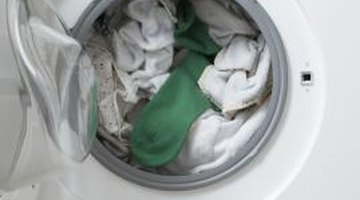How to Build a Gray Water Sump Pump
Gray water is used waste water from bath tubs, bath lavatories, washing machines and showers. The most common and trouble-free method of collecting gray water is from the washing machine drain. You can collect this machine's waste water and reuse it for irrigating landscape plants or diverting it into a dry well. With this system, gravity will draw the drain water from the appliance and send it to a sump pump well or basin. Once the basin is full, the sump pump will turn on, channeling your gray water through an exterior distribution pipe.

Step 1
Create a sump pump well with the plastic tub by placing the sump pump machine into the tub. For best results, place the tub in the basement below the washing machine and near an exit such as a window or basement door. Cut away the two knock-out holes in the tub to allow one pipe in and another pipe out. If possible, place the tub in an existing sump pump well or on a flat, level area on the floor.
Step 2
Locate the PVC drain line for your washing machine. This pipe is usually against the wall or inside the wall behind the washer. The washing machine's black, flexible drain pipe is usually hung into the pipe. Remove the washing machine drain pipe and temporarily place it in a bucket.
Step 3
Measure and cut sections of PVC pipe to create a new drain pipe for the washing machine that leads to the sump pump plastic tub. This new pipe system will stand parallel to the old system, allowing you to drain the washing machine's gray water to the sump pump or into the existing sewer or septic system.
Step 4
Connect the PVC portions together with PVC cement, following the instructions on the cement container carefully. Allow the sections to dry.
Step 5
Clamp the new PVC pipe to the wall behind the washer and next to the existing PVC drain pipe with pipe clamps and screws Place a flexible short cap specially made for PVC pipes over the existing sewer or septic drain pipe. This cap prevents sewer gases from entering the house when you use the gray water drain system.
Step 6
Wrap a loose quantity of nylon stockings or cheesecloth to the end of the washing machine drain pipe to create a loose bag. Use rubber bands to secure the material around the end of the pipe. Use this material to catch lint and other debris from the gray water to prevent particles from entering the gray water pipe line and sump pump, where debris can cause damage to the pump. Remove the material from the pipe whenever you place the washer drain pipe back into the existing PVC sewer or septic line.
Step 7
Connect the end of the new PVC pipe system to the intake valve on the sump pump appliance in the plastic tub. Read the sump pump directions carefully, as pump and pipe connections vary, depending on the manufacturer.
Step 8
Measure and cut sections of PVC pipe to create the distribution pipe system. Depending on your use of the gray water, you can either connect the PVC pipes to corrugated and perforated black pipes for an irrigation system or connect a longer section of PVC pipe and divert the gray water to a dry well system or other waste water system approved for use in your region.
References
Warnings
- Some states prohibit or regulate the use of gray water and gray water pump systems. Before you begin your project, consult with your local building codes department to determine any regulations for gray water recycling systems.
- Never spray gray water directly into the air or onto food plants, such as garden vegetable plants. Gray water may contain bacteria or viruses that, when eaten, can cause severe health consequences. Use the gray water for drip irrigation purposes only.
- Avoid using hazardous or strong cleaning chemicals in your laundry or shower. These chemicals remain in the water and leach into the soil, harming plants and disturbing the microbiological ecosystem of the soil and environment.
- Do not use gray water from washing machines that have washed cloth diapers or other types of soiled materials.
- Regularly check the nylon stocking for lint and debris, and replace as necessary. Failure to remove built-up debris can cause the gray water to overflow from the washing machine pipe.
Writer Bio
Rebecca Mecomber, a former radio broadcaster, has been a professional blogger and writer since 2006. Her articles and interviews have appeared in "The Wall Street Journal," Salon.com and several other publications, covering topics such as Federal Trade Commission policy and media regulations, blogging, home improvement and New York travel.
Photo Credits
- Martin Poole/Lifesize/Getty Images
More Articles



